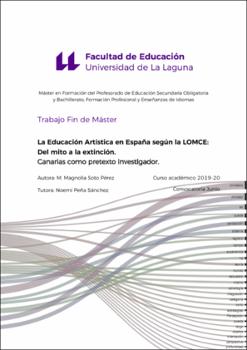La Educación Artística en España según la LOMCE: del mito a la extinción. Canarias como pretexto investigador.
Fecha
2020Resumen
In this research we intend to establish a reflection on the role of Arts Education in today’s
society as an essential component in the training of students of any educational level, so
that they are able to identify the shaping elements of visual literacy, and can manifest a
critical attitude towards the visual culture around them. We have reviewed the role of
Arts Education in Spain through the analysis of its educational regulations with the aim
of defining the position, influence and scope of Arts Education in relation to other
subjects. At the same time, we have begun a reflection on access to the teaching function
through the Drawing Specialty and focus our attention on the contents of the current
syllabus dating from 1993. We have used text analysis and data visualization tools to
establish a comparison between curriculum and syllabus, and to confirm the status of
both. We have moved from giving the floor to sharing the image, immersed in an
eminently visual and audiovisual society, a fact that has not been reflected in any of the
aspects analysed. This situation requires the recovery of weight and space in Artistic
Education, not as a nineteenth-century academic subject, but as an essential component
for achieving an integral formation of citizenship En esta investigación pretendemos establecer una reflexión sobre la función de la
Educación Artística en la sociedad actual como componente imprescindible en la
formación de los estudiantes de cualquier nivel educativo, para que sean capaces de
identificar los elementos configuradores de la alfabetidad visual, y puedan manifestar una
actitud crítica hacia la cultura visual que les rodea. Hemos revisado el papel de la
Educación Artística en España a través del análisis de su normativa educativa con el
objetivo de definir la posición, la influencia y el alcance de la Educación Artística frente
a otras materias. En paralelo, hemos iniciado una reflexión sobre el acceso a la función
docente a través de la Especialidad de Dibujo, y focalizamos nuestra atención en los
contenidos del temario vigente que datan de 1993. Hemos utilizado herramientas de
análisis de texto y visualización de datos para establecer una comparativa entre currículo
y temario, y confirmar el estado de ambos. Hemos pasado de dar la palabra a compartir
la imagen, inmersos en una sociedad eminentemente visual y audiovisual, hecho que no
ha quedado reflejado en ninguno de los aspectos analizados. Esta situación pasa por la
recuperación de peso y espacio de la Educación Artística, no como una materia
decimonónica de carácter academicista, sino como componente imprescindible para
lograr una formación integral de la ciudadanía





